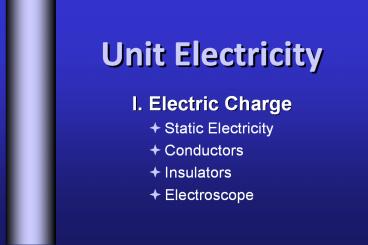Unit Electricity - PowerPoint PPT Presentation
1 / 31
Title:
Unit Electricity
Description:
Unit Electricity I. Electric Charge Static Electricity Conductors Insulators Electroscope What do these have in common? A. Static Electricity Static Electricity the ... – PowerPoint PPT presentation
Number of Views:201
Avg rating:3.0/5.0
Title: Unit Electricity
1
Unit Electricity
- I. Electric Charge
- Static Electricity
- Conductors
- Insulators
- Electroscope
2
What do these have in common?
3
A. Static Electricity
- Static Electricity
- the net accumulation of electric charges on an
object - Electric Field
- force exerted by an e- on anything that has an
electric charge - opposite charges attract
- like charges repel
4
A. Static Electricity
- Static Discharge
- the movement of electrons to relieve a separation
in charge
5
B. Conductors
- Conductor
- material that allows electrons to move through it
easily - e- are loosely held
- ex metals like copper and silver
6
C. Insulators
- Insulator
- material that doesnt allow electrons to move
through it easily - e- are tightly held
- ex plastic, wood, rubber, glass
7
D. Electroscope
- Electroscope
- instrument that detects the presence of
electrical charges - leaves separate when they gain either a or -
charge
8
- II. Electric Current
- Circuit
- Potential Difference
- Current
- Resistance
- Ohms Law
9
Potential Difference
10
B. Potential Difference
- Potential Difference (voltage)
- difference in electrical potential between two
places - large separation of charge creates high voltage
- the push that causes e- to move from - to
- measured in volts (V)
11
C. Current
- Current
- flow of electrons through a conductor
- depends on of e- passing a point in a given
time - measured in amperes (A)
12
D. Resistance
- Resistance
- opposition to the flow of electrons
- electrical energy is converted to thermal energy
light - measured in ohms (?)
13
Resistance
- Caused by internal friction in conductor and
slows the movement of charges. - A 40 W light bulb is dim and has a higher
resistance than a bright 100W light bulb.
14
- https//www.youtube.com/watch?vKvVTh3ak5dQ
- Resistance video
15
D. Resistance
- Resistance depends on
- the conductor
- wire thickness
- less resistance in thicker wires
- wire length
- less resistance in shorter wires
- temp - less resistance at low temps
16
E. Ohms Law
- Ohms Law
V potential difference (V) I current
(A) R resistance (?)
V I R
- Voltage increases when current increases.
- Voltage decreases when resistance increases.
17
E. Ohms Law
- A lightbulb with a resistance of 160 ? is plugged
into a 120-V outlet. What is the current flowing
through the bulb?
KNOWN/UNKNOWN R 160 ? V 120 V I ?
EQUATION I V R
WORK I (120 V) (160 ?) I 0.75 A
18
Superconductors
Some metals have zero resistance when their
temperature falls below a certain temperature
(critical temperature). The range is from -458º
F to -189ºF.
19
- III. Electrical Circuits
- Circuit components
- Series circuits
- Parallel circuits
- Household circuits
20
- https//www.youtube.com/watch?vl8JS8BbrVOg
- Video
- https//www.youtube.com/watch?vlYZUXV-v71Y
21
- https//www.youtube.com/watch?vD2monVkCkX4
- Circuits
22
A. Circuit
- Circuit
- closed path through which electrons can flow
23
A. Circuit Components
- A - battery C - light bulb
- B - switch D - resistor
24
B. Series Circuits
- Series Circuit
- current travels in a single path
- one break stops the flow of current
- current is the same throughout circuit
- lights are equal brightness
- each device receives a fraction of the total
voltage - get dimmer as lights are added
25
C. Parallel Circuits
- Parallel Circuits
- current travels in multiple paths
- one break doesnt stop flow
- current varies in different branches
- takes path of least resistance
- bigger light would be dimmer
- each device receives the total voltage
- no change when lights are added
26
D. Household Circuits
- Combination of parallel circuits
- too many devices can cause wires to overheat
- Safety Features
- fuse - metal melts, breaking circuit
- circuit breaker - bimetallic strip bends when
hot, breaking circuit
27
- IV. Measuring Electricity
- Electrical Power
- Electrical Energy
28
A. Electrical Power
- Electrical Power
- rate at which electrical energy is converted to
another form of energy
P power (W) I current (A) V potential
difference (V)
P I V
29
A. Electrical Power
- A calculator has a 0.01-A current flowing through
it. It operates with a potential difference of 9
V. How much power does it use?
KNOWN/UNKNOWN I 0.01 A V 9 V P ?
EQUATION P I V
EQUATION P (0.01 A) (9 V) P 0.09 W
P
V
I
30
B. Electrical Energy
- Electrical Energy
- energy use of an appliance depends on power
required and time used
E energy (kWh) P power (kW) t time (h)
E P t
31
B. Electrical Energy
- A refrigerator is a major user of electrical
power. If it uses 700 W and runs 10 hours each
day, how much energy (in kWh) is used in one day?
UNKNOWN/KNOWN P 700 W 0.7 kW t 10 h E ?
WORK E P t E (0.7 kW) (10 h) E 7 kWh
EQUATION E P t
E
t
P

